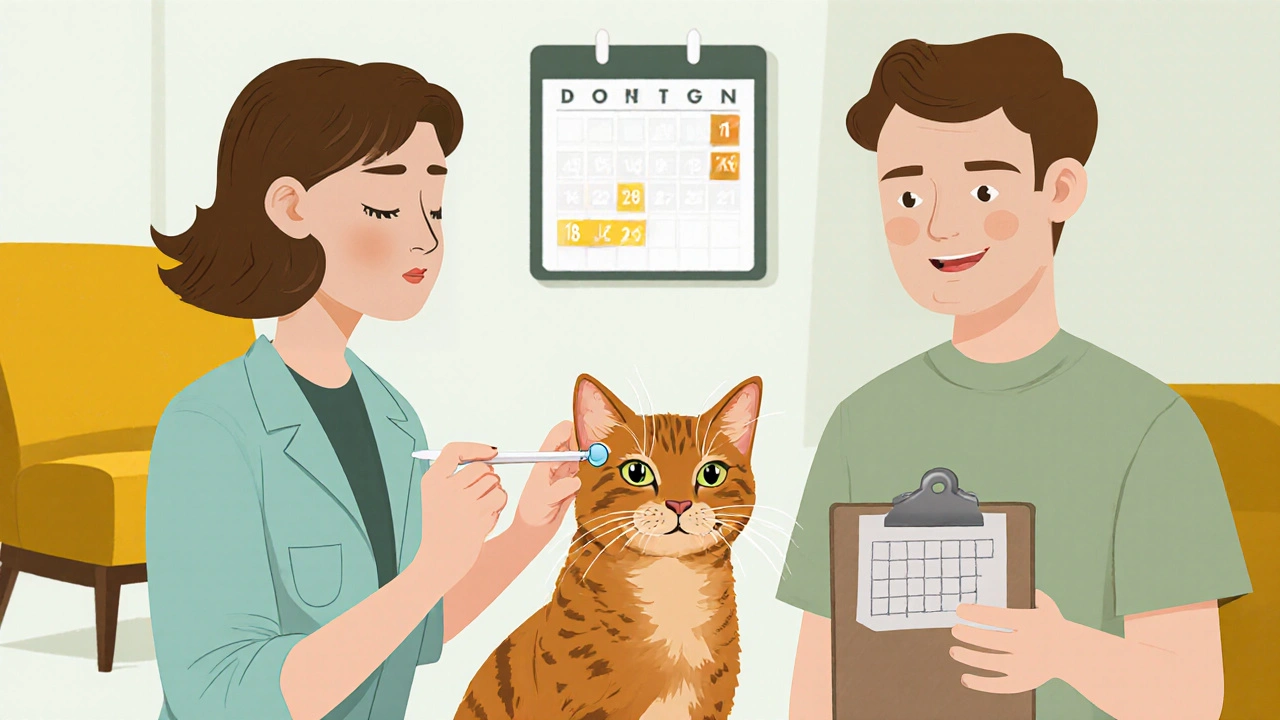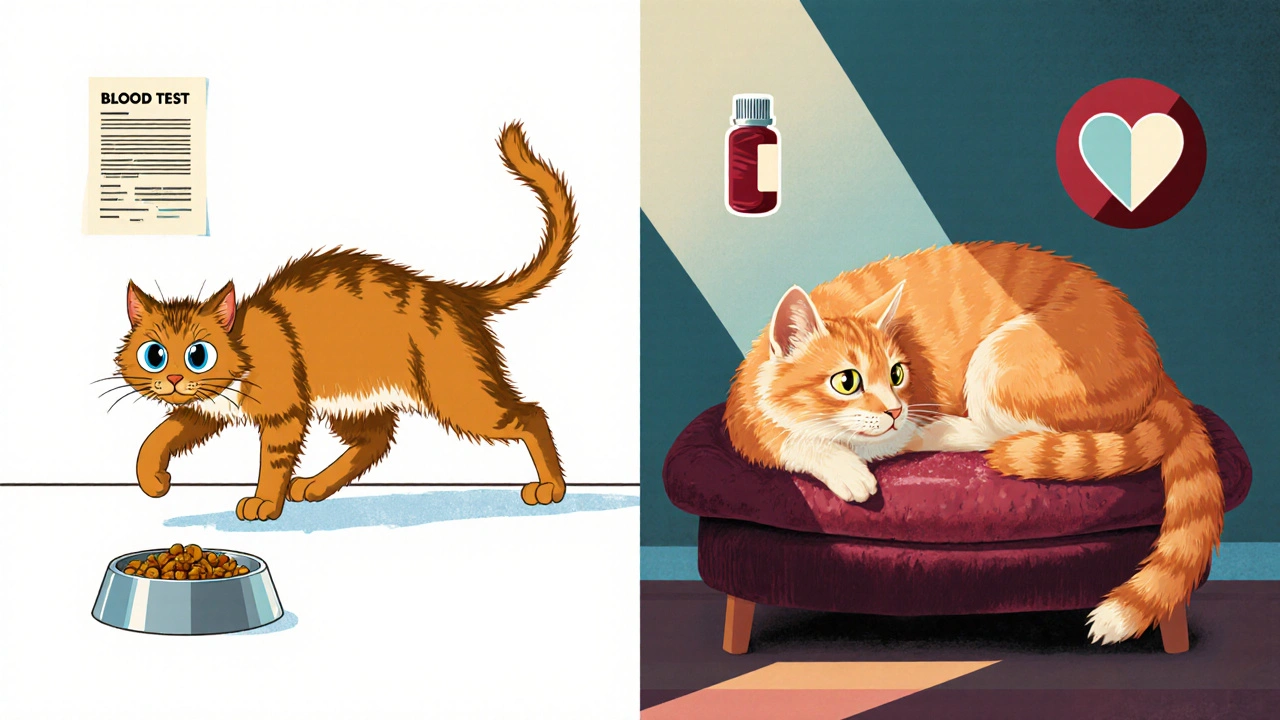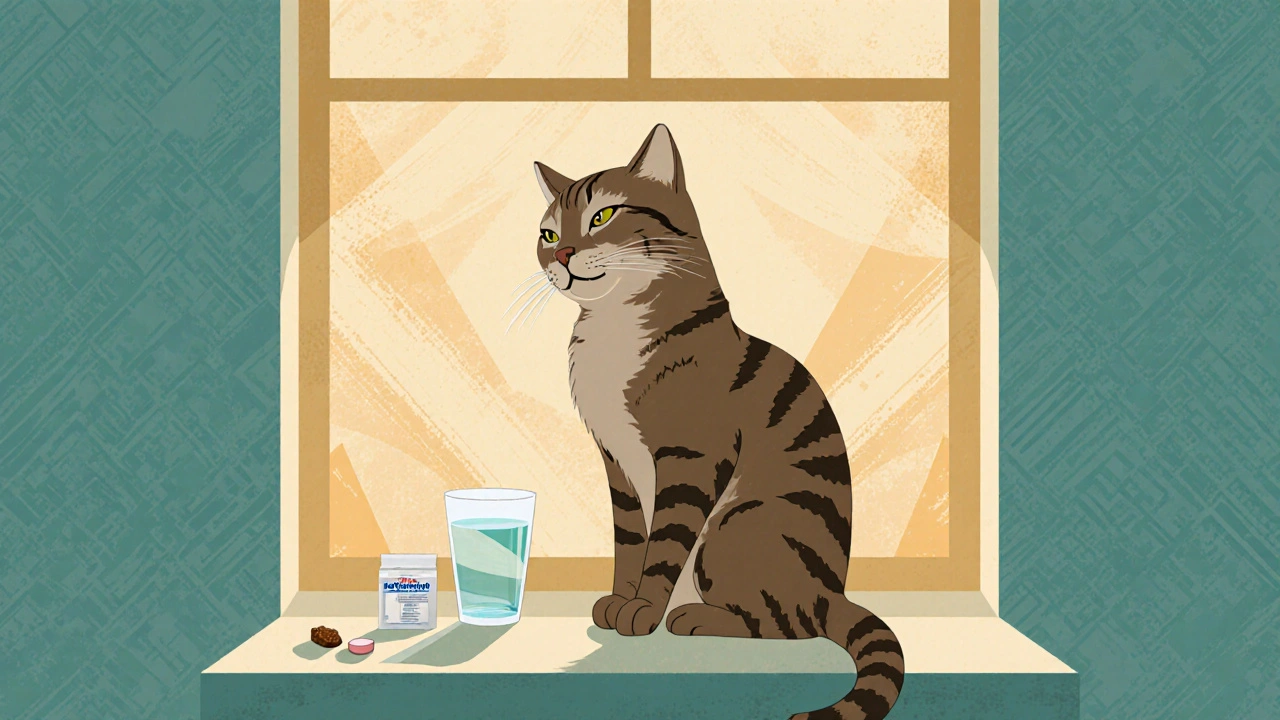Hyperthyroidism is the most common hormone problem in older cats. If your cat is losing weight but eating more, acting restless, vomiting often, or meowing louder than usual, it might not just be aging-it could be an overactive thyroid. The good news? There’s a proven, widely used medication called methimazole that can bring things back under control.
What Is Methimazole?
Methimazole is an antithyroid drug that stops the thyroid gland from making too much thyroid hormone. It doesn’t cure hyperthyroidism, but it controls it. For most cats, this means they can live comfortably for years without surgery or radioactive treatment.
The drug works by blocking the enzyme that turns iodine into thyroid hormones. Without that enzyme working overtime, hormone levels drop. It’s the same medication used in humans with Graves’ disease, but the dosage is adjusted for a cat’s small body. Most vets prescribe it as a 5 mg tablet, though it’s also available as a liquid or a transdermal gel you rub on the inside of the ear.
How Do You Know If Your Cat Has Hyperthyroidism?
It’s easy to miss at first. Many owners think their cat is just ‘getting picky’ or ‘more energetic.’ But here are the real signs:
- Unexplained weight loss, even with a big appetite
- Increased thirst and urination
- Hyperactivity, pacing, or restlessness
- Vomiting or diarrhea
- Poor coat condition-matted, greasy, or dull fur
- Loud, persistent meowing, especially at night
- Fast heart rate or breathing
One study from the University of Glasgow found that over 70% of cats over age 10 show some sign of elevated thyroid hormone levels. Not all need treatment, but if your cat has symptoms and blood tests confirm high T4 levels, methimazole is often the first step.
How Is Methimazole Given to Cats?
There are three main ways vets give methimazole to cats:
- Tablets - The most common form. You can hide them in treats, use a pill pocket, or crush them and mix with wet food. Some cats are picky, so flavoring the food helps.
- Transdermal gel - Applied to the inner ear (not the tip). The skin there absorbs the drug. This is great for cats who hate pills, but absorption can be uneven. Some cats end up with higher or lower levels than expected.
- Liquid form - Less common, but useful for very small cats or those with swallowing issues. Requires a special compounding pharmacy.
Dosing usually starts at 2.5 mg once or twice daily. Your vet will check thyroid levels after 2-4 weeks and adjust. Some cats need 5 mg twice a day; others do fine on 2.5 mg once a day. It’s not one-size-fits-all.
Side Effects of Methimazole in Cats
Most cats tolerate methimazole well. But about 20% have mild side effects in the first few weeks:
- Loss of appetite
- Vomiting
- Lethargy
- Itching or redness on the face or ears (especially with gel)
These usually go away on their own. If they don’t, your vet may lower the dose or switch forms.
Rarely-less than 5% of cases-cats develop serious reactions:
- Low white blood cell count (increased infection risk)
- Liver damage (yellow gums, dark urine, severe vomiting)
- Bleeding disorders (bruising, nosebleeds)
If your cat gets any of these, stop the medication and call your vet immediately. Blood tests every 3-6 months catch these early.
How Long Does It Take to Work?
You won’t see a miracle overnight. Most cats start feeling better in 2-4 weeks. Appetite improves, energy levels stabilize, and weight gain begins. But it takes 6-12 weeks for thyroid levels to fully normalize. That’s why follow-up blood work is non-negotiable.
Some owners think if their cat seems fine, they can skip tests. Don’t. Too much methimazole can cause hypothyroidism (underactive thyroid), which is just as dangerous. Too little, and the hyperthyroidism keeps damaging the heart and kidneys.

Can Methimazole Cure Hyperthyroidism?
No. It only manages it. If you stop giving it, the thyroid will go back to overproducing hormones. That’s why most cats stay on methimazole for life.
But there are two other options that can cure it:
- Radioactive iodine therapy - A one-time injection that destroys the overactive thyroid tissue. It’s 95% effective. But it’s expensive ($1,000-$1,500), requires a 1-2 week hospital stay, and isn’t available everywhere.
- Surgery - Removing the affected thyroid lobe. Risky if the cat has heart disease. Also requires lifelong hormone replacement if both lobes are removed.
Most owners choose methimazole because it’s affordable, non-invasive, and reversible. You can stop it anytime if side effects appear.
What Happens If You Don’t Treat It?
Left untreated, hyperthyroidism doesn’t just make your cat feel bad-it kills them slowly.
The excess thyroid hormone speeds up the heart, leading to hypertrophic cardiomyopathy. The kidneys work overtime to filter the extra waste, which can cause permanent damage. High blood pressure develops, risking blindness from retinal detachment.
A 2023 study from the Royal Veterinary College found that untreated hyperthyroid cats lived an average of 14 months after diagnosis. Cats on methimazole lived over 4 years-with good quality of life.
How to Give Methimazole Without a Fight
Getting a pill into a cat can feel like a wrestling match. Here’s what works:
- Use a pill gun. It’s cheap, safe, and avoids your fingers near claws.
- Hide the pill in a small piece of tuna, chicken, or a commercial pill pocket. Avoid cheese-it can upset their stomach.
- For transdermal gel: Use a clean cotton swab, apply to the hairless part of the inner ear, and rub gently. Wash your hands after.
- Keep a log: Date, time, dose, any side effects. This helps your vet adjust faster.
Some cats learn to spit out pills. If that happens, try the gel. If the gel causes ear irritation, go back to tablets. There’s no perfect solution-just the one that works for your cat.
Cost of Methimazole for Cats
It’s one of the most affordable treatments. A 30-day supply of generic methimazole tablets costs between $15 and $30 in the UK. The transdermal gel costs more-around $50-$70 a month-because it’s compounded.
Compare that to radioactive iodine ($1,200+) or surgery ($1,000-$2,000). Even with monthly blood tests ($40-$80), methimazole is far cheaper long-term.

When to Call the Vet
Call immediately if your cat:
- Stops eating for more than 24 hours
- Starts vomiting blood or has black, tarry stools
- Has seizures, extreme weakness, or collapse
- Shows signs of jaundice (yellow gums or skin)
For anything else-loss of appetite for a day, mild vomiting, or lethargy-wait 24 hours. If it doesn’t improve, call your vet. Don’t stop the medication unless told to.
Can You Use Human Methimazole for Your Cat?
Technically, yes-it’s the same chemical. But never do it without vet guidance.
Human tablets are often 5 mg or 10 mg. Your cat needs a fraction of that. Crushing and splitting pills can lead to dangerous overdoses. Plus, human formulations may contain fillers that are toxic to cats.
Always use vet-approved methimazole. It’s formulated for pets and comes in the right strength. Your vet can also help you find the most cost-effective source.
Long-Term Management
Methimazole isn’t a cure, but it’s a lifeline. With regular dosing and blood tests, most cats live 5-10 more years with normal energy, good appetite, and soft fur.
Keep a routine: Same time every day, same form, same food. Stress affects thyroid levels, so try to keep the home calm. Use pheromone diffusers if your cat gets anxious.
Also, monitor kidney function. Hyperthyroidism can hide kidney disease. Once you treat the thyroid, the kidneys may show damage that was masked before. Your vet will check creatinine and BUN levels regularly.
Many owners say their cat becomes a different animal after starting methimazole-calmer, cuddlier, quieter. That’s not just imagination. It’s the thyroid hormone returning to normal.
Final Thoughts
Methimazole isn’t glamorous. It’s not a miracle cure. But for thousands of cats each year, it’s the difference between a slow decline and years of happy, purring life. It’s affordable, safe, and effective-if you’re consistent.
Don’t wait for symptoms to get worse. If your senior cat is acting off, ask your vet for a thyroid test. Early treatment means better outcomes. And with methimazole, you’re not just managing a disease-you’re giving your cat back their life.
Can methimazole be stopped if my cat seems better?
No. Stopping methimazole will cause thyroid hormone levels to rise again, and symptoms will return. It’s a lifelong treatment for most cats. Even if your cat looks fine, the underlying condition hasn’t changed. Always follow your vet’s advice on dosing and testing.
Is methimazole safe for older cats?
Yes, it’s one of the safest options for senior cats. Most cats over age 12 tolerate it well. The main concern is kidney function, which can be masked by hyperthyroidism. Your vet will monitor both thyroid and kidney levels regularly to ensure balance.
Can I give methimazole with food?
Yes, but it’s best given on an empty stomach for consistent absorption. If your cat vomits or refuses to take it without food, give it with a small amount of wet food. Avoid high-iodine foods like fish or seaweed-based treats-they can interfere with the drug’s effect.
What should I do if I miss a dose?
If you miss one dose, give it as soon as you remember. If it’s close to the next scheduled dose, skip the missed one and resume the regular schedule. Never double the dose. Missing one dose won’t cause harm, but frequent missed doses can lead to hormone spikes and worsen symptoms.
Are there natural alternatives to methimazole?
No proven natural alternatives exist. Supplements like L-carnitine or iodine-restricted diets may help slightly, but they are not substitutes for methimazole. Hyperthyroidism is a medical condition requiring hormone regulation. Relying on unproven remedies can delay treatment and cause serious harm.


John Rendek
November 2, 2025 AT 03:32Methimazole is a game-changer for senior cats. My 14-year-old Tabby was down to 6 pounds and meowing all night. Started on 2.5mg twice daily, and within three weeks, she was purring on the couch again. Bloodwork every 6 months keeps us on track. No magic cure, but it’s the closest thing to a second chance.
Sonia Festa
November 2, 2025 AT 10:59Ugh, I tried the gel. My cat looked like she’d been attacked by a glitter bomb. Ear was red, she was head-shaking like a wet dog. Then I switched to pills hidden in salmon paste - she devours it like it’s a treat. Don’t let the ‘easy’ options fool you. Sometimes the annoying way is the only way that works.